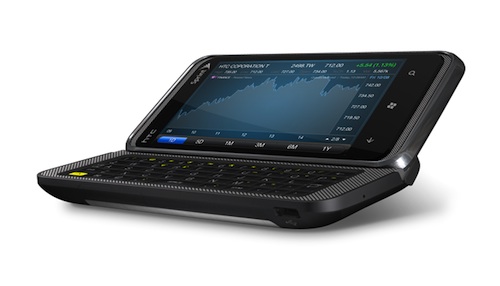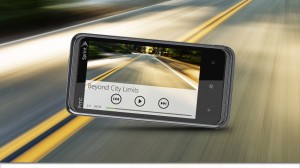
Wow, it’s pretty. That’s the first thought I had when I picked up my first review smartphone running Windows Phone 7, Microsoft’s attempt to stave off irrelevance in the mobile phone operating system market.
The user interface exudes style. I’d argue it has a better-looking UI than Apple’s iOS (which powers the iPhone and iPad), Google’s Android and Nokia’s Symbian.
I know that not everyone likes the artistic design touches, where text headers sometimes flow off the screen, but I reckon Microsoft has designed a drop-dead gorgeous piece of software. The e-mail application, in particular, is stunning with its minimalistic black and grey styling and smoothed fonts.
On our test phone, the HTC 7 Pro slider, the software is also snappy, with animated transitions as smooth as silk. That’s perhaps not surprising given that a 1GHz Snapdragon processor powers the device.
Compared to Windows Mobile, Phone 7 represents a giant leap forward for Microsoft. It’s caught up — for the most part — with Android and iOS, and is miles ahead of the tired Symbian.
In addition to the best-in-class e-mail client, the Internet Explorer Web browser is more than competent. The tiles on the home screen also make it a snap to move quickly between apps. And adding software to the home screen is as easy as dragging them there.
The on-screen keyboard also works well. It’s better than the default Android (version 2.2) keyboard and on a par with iOS’s soft Qwerty.
But the software isn’t perfect. Though the UI is excellent, I get the impression that Microsoft rushed the product to market. One of the menus, for example, has a spelling error: “ensable” instead of “enable”.
Another gripe is the way Microsoft wastes space on the home screen by only using about four-fifths of its real estate for the tiles, leaving large black lines at the top and right-hand side. It’d be great to use that space for small widgets, like a weather app or a clock.
Also, the home screen doesn’t auto rotate. I know Android and iOS don’t do this either, but on Phone 7 the UI means it’s not hard to implement.
The Windows Marketplace also lacks apps. These will come in time, but for now the Microsoft app store is like a desert next to what’s on offer in the lush, green forests of the Android Market and the Apple App Store. In this regard, Microsoft faces the same challenges as Nokia. Until there’s more software on offer, many users will migrate instead to iOS and Android.

But this is probably not Microsoft biggest challenge in convincing consumers to try Phone 7. Rather, the company has to fight an uphill battle to overcome perceptions that Windows is simply not cool.
Over lunch recently, the CEO of one of SA’s mobile operators made the point that people, especially youngsters, don’t want to be caught dead with a phone their friends perceive as unfashionable.
Everyone wants an iPhone; the same cannot be said of Windows-powered handsets. Rightly or wrongly, Microsoft is perceived as dull and grey; Apple, on the other hand, has cultivated a hip-and-happening brand.
Microsoft needs to recreate its brand image. But I’m not sure it can. It doesn’t have the culture or the marketing savvy to pull it off.
Then there’s the fact that many users have bad memories of Windows Mobile, which, let’s face it, was dreadful. Microsoft made the mistake of trying to shoehorn the look and feel of the Windows desktop onto a mobile phone. The result was awful. People who had the misfortune of buying an earlier-generation Windows handset won’t easily go back.
And it’s taken Microsoft three years to come up with something that can compete with iOS and Android. It hasn’t overtaken its rivals with Phone 7, and that may not be good enough in this highly competitive market.
In some respects it still lags its rivals. Bing voice search is not nearly as good as Google’s, for instance. When I spoke “TechCentral, South Africa” into the HTC 7 Pro, Bing returned “Jacksonville, Oregon”. A moment later, the same test using Google on Android returned the correct result the first time.
So, although Phone 7 is a major step up from Windows Mobile, Microsoft is not out of the woods yet. For now, Android looks set to become the dominant operating system on smartphones and tablet computers, with iOS filling a highly profitable niche on Apple hardware.
To have any chance of catching up, and attaining relevance in the booming smartphone market, Microsoft is going to have to release significant updates to Phone 7 on a regular basis and bring better Internet services to the platform.
Even then, it’s going to be an uphill battle.
As for the 7 Pro, HTC is fast gaining a reputation for building beautiful high-end smartphones than run both Android and Windows Phone software. The 7 Pro is on the heavy side at 185g, but it does have a full slide-out keyboard (with generously sized keys) and swivel screen.
The device, which has a vivid, 3,6-inch screen (480×800-pixel resolution), supports 3G up to 7,2Mbit/s and Wi-Fi b/g and n connections. The 3G supports 900MHz frequency, so will work on Cell C’s new network.
It also has an integrated GPS, digital compass, 5-megapixel camera that can shoot video at 720p resolution, 8GB of internal memory and good quality speakers. — Duncan McLeod, TechCentral
- Subscribe to our free daily newsletter
- Follow us on Twitter or on Facebook




